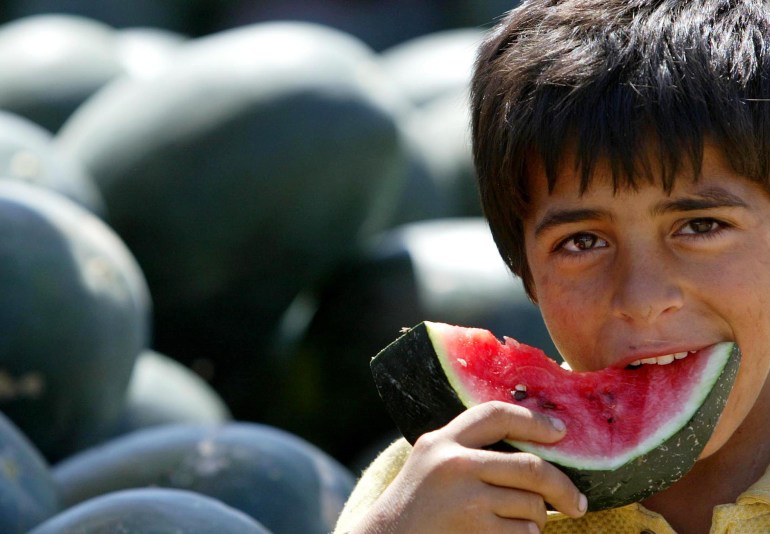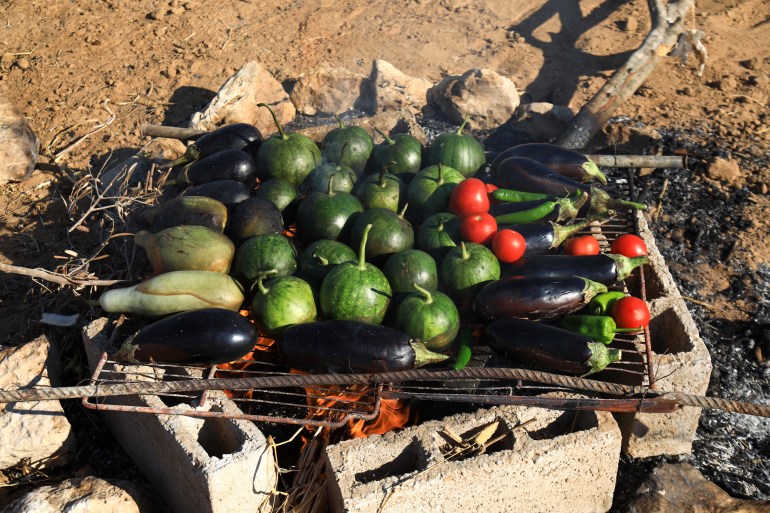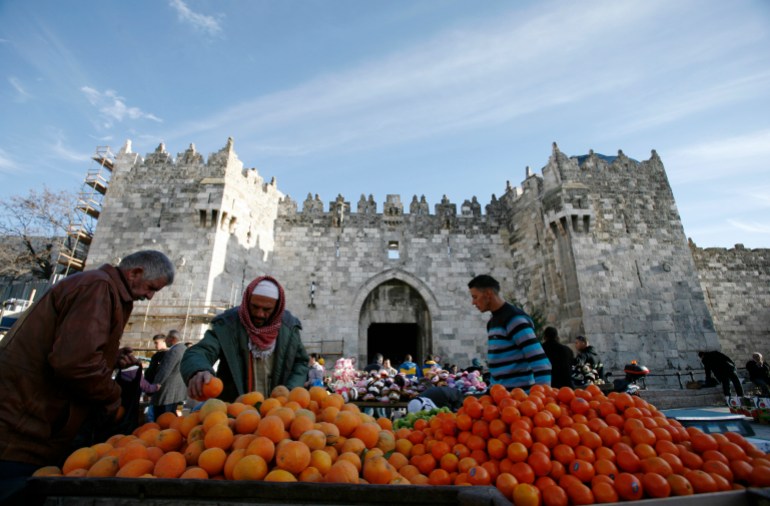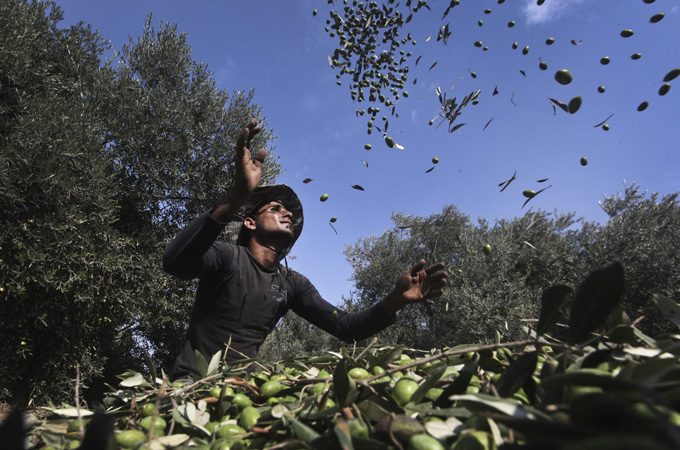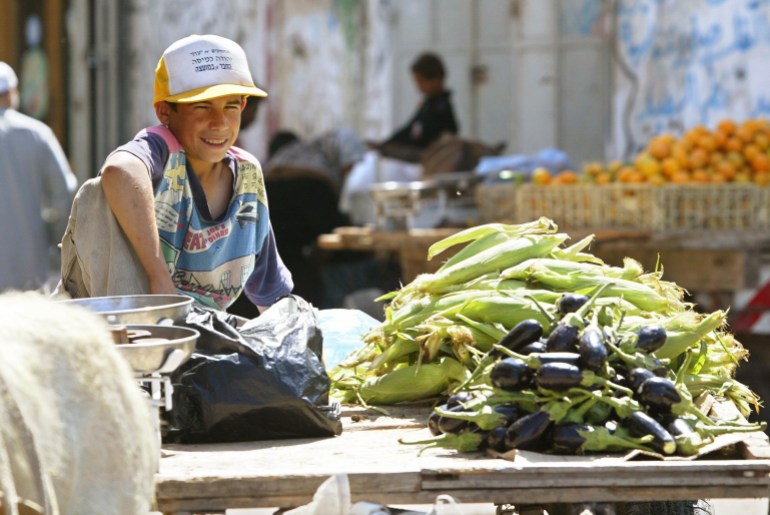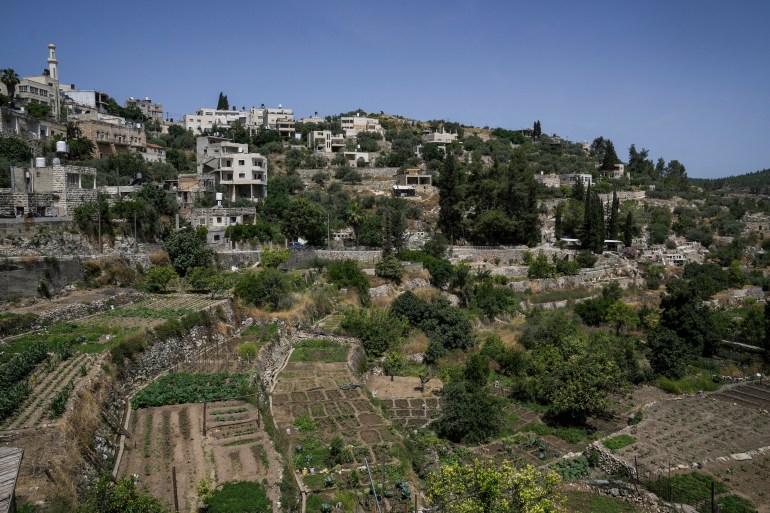Rebecca Gordon-Nesbitt and Asa Winstanley
25 August 2023

The Campaign Against Antisemitism organized protests against Jeremy Corbyn when he was leader of Britain’s Labour Party. Ben CawthraSIPA USA
The Campaign Against Antisemitism recently took credit for persuading UK trade union Unite to cancel the Bristol launch of Asa Winstanley’s book Weaponising Anti-Semitism, alongside an associated screening of the film Oh Jeremy Corbyn: The Big Lie.
This was only the latest in a long series of attacks by the Israel lobby group targeting the Palestine solidarity movement and the wider left.
But The Electronic Intifada can today reveal that the CAA has been given almost half a million dollars by the UK partner of the Jewish National Fund, Israel’s quasi-governmental settler-colonial agency.
The donations were hidden in obscure Charity Commission documents uncovered by our research. In an email to The Electronic Intifada, the CAA confirmed it had been in “past receipt of donations from JNF UK” but denied current JNF funding.
“JNF UK has never exercised or sought to exercise any influence over our activities,” the CAA claimed.
The 2018 and 2019 donations were later reclassified by the JNF as fundraising costs, implicating the CAA in Israeli settler-colonization efforts.
Founded in 1901, the JNF – known in Israel as Keren Kayemeth LeIsrael – is committed to colonizing historic Palestine.
It is one of Israel’s four key “National Institutions” which, since 1948 have worked “to advance the Zionist enterprise.” The JNF has been described by noted Israeli historian Ilan Pappé as a “colonialist agency of ethnic cleansing.”
Founded in Britain in 1908 and registered in 1939 as a charity operating in “Israel” – a state which had not yet been established – the JNF’s British partner group JNF UK says it has been “building Israel for over a century.”
It does so by fundraising in the UK and passing the money collected onto Israel, primarily for projects in the southern Naqab desert, displacing Palestinian citizens of Israel in favor of Jewish settlers.
JNF UK has also funded a number of projects supporting illegal settlements in the West Bank – a war crime under international law.
JNF funding to CAA
Founded in 2014, the CAA was formally registered as a charity the following year.
UK law requires charities to declare all donations they receive from organizations with common trustees as “related party transactions.”
An analysis of the CAA’s accounts, crosschecked with those of the JNF’s British partner shows that the CAA has received large donations from JNF UK.
Crucially, these donations were made during the most intense period of the manufactured anti-Semitism crisis in Britain’s Labour Party in 2018 and 2019.
CAA chief executive Gideon Falter was in 2017 appointed as a director and trustee of JNF UK and he is also a vice chair.
In 2018, the CAA declared in its accounts disclosed to the Charity Commission that a donation of almost $220,000 had come from a “related party.”
This amounted to nearly half of its income for that year.
Funding a “crisis”
The following year, the CAA declared that $230,000 had come from a similarly undisclosed “related party.”
The 2019 figure amounted to 20 percent of its income but 60 percent of its expenditure.
In 2019, JNF UK declared expenditure of the exact same amount as the donation declared by the CAA that same year.
JNF UK paid $230,000 “for grants provided to a UK charity, which has a trustee who is also a trustee of JNF Charitable Trust.”
According to its website, “JNF Charitable Trust” is simply the official name of the JNF UK charity and they “are the same” group.
The 2019 JNF UK accounts also stated that in 2018 it had made a donation of almost $220,000 to the same unnamed “UK charity.”
In other words, both the 2018 and the 2019 donations from JNF UK were the exact same amounts as those received by the CAA in the exact same years – totaling $450,000.
Given that the donations for both years from JNF UK are exactly the same as the mysterious donations to the CAA from a “related party,” and given that CAA trustee Gideon Falter is also a trustee of JNF UK, the most logical conclusion is that JNF UK donated both these sums.
And the CAA’s email confirming that it had received “donations from JNF UK … some years ago” puts that conclusion beyond a reasonable doubt.
This means that JNF UK funded the CAA to the tune of nearly half a million dollars during the most intense period of its “anti-Semitism crisis” campaign against Labour and its then leader Jeremy Corbyn in 2018 and 2019.
Electoral interference
It was during this period that the CAA’s lawyers referred the Labour Party to the Equality and Human Rights Commission alleging “institutional anti-Semitism.” This also covers the period of the 2019 general election.
All this suggests that the JNF’s British partner financially supported both the CAA’s legal action against the Labour Party and its negative campaigning during the 2019 general election.
According to JNF UK’s 2019 accounts, its accounts for 2018 were later altered “to show a reclassification of a grant made to a UK charity previously shown under UK Charitable Projects.” The beneficiary would now instead be “included under [JNF] fundraising.”
JNF UK’s funding to the CAA was thereby redefined. No longer was it to be understood as a simple grant to a UK charity.
Instead, the financial support was given to help the JNF’s own efforts.
In other words, the CAA had become an active part of the machinery of fundraising for Israel’s occupation.
In its statement emailed to The Electronic Intifada, the CAA denied ever fundraising “for JNF UK.” The CAA declined to comment further when asked to explain JNF UK’s own accounts stating that it had.
Attacking Palestinians
The CAA was founded in 2014 during Israel’s deadly war on the population of the Gaza Strip. Jewish anti-Zionist author and activist Tony Greenstein has described the group as a “campaign against Palestinians.”
It has attacked Palestinians in the UK, as well as the wider solidarity movement.
Palestinian academic Shahd Abusalama was pushed out of her job at Sheffield Hallam University last year after a relentless campaign by the CAA.
In 2017 the group attacked Malaka Mohammed – then a student at the University of Exeter – smearing her as a “terrorist-supporting anti-Semite.”
The group has encouraged its supporters to go onto British campuses and “record, film, photograph and get witness evidence” during Palestine solidarity events such as Israeli Apartheid Week. A group of more than 240 academics wrote to The Guardian in 2017 referring to the CAA’s “outrageous interferences with free expression” and “direct attacks on academic freedom.”
Attacking Labour
The CAA made the Labour Party its main target during the leadership of Jeremy Corbyn, who is a veteran Palestine solidarity campaigner.
Throughout Corbyn’s leadership, the group was at the forefront of claims of rampant anti-Semitism in the Labour Party, organizing demonstrations and petitions and amplifying anti-Corbyn voices.
In 2016, more than 100 left-wing Jewish activists wrote an open letter against “the pro-Israel lobbyists of the Campaign Against Antisemitism” and their attacks on Labour.
Even Labour lawmaker Margaret Hodge – herself one of the leading weaponizers of anti-Semitism against Corbyn and the left – has said that the CAA is guilty of “using anti-Semitism as a front to attack Labour.”
After Corbyn was defeated at the 2019 general election, the CAA took credit, with leading CAA researcher Joe Glasman claiming it had “slain” Corbyn, “the beast.”
Lobbying for Israel
The CAA claimed its first dubious victory in 2014, during the aforementioned war on Gaza.
In response to Israel’s violence, London’s Tricycle Theatre asked the UK Jewish Film Festival (which the theater was due to host) to return around $2,500 in funding it had received from the Israeli embassy. The theater made clear it wanted the festival to go ahead and even offered to replace the funds itself.
Consistent with the state of Israel’s aggressive strategy of combating “delegitimization,” the CAA was instrumental in promoting the lie that the theater was going to boycott the festival.
The nascent group led a protest outside the theater, waving Israeli flags and carrying placards featuring such slogans as “No to Jewish Film Festival Ban” and “Tricycle Theatre: We Support Israel.” The CAA explained at the time that the placards “were carried by strongly Zionist Jews who also carried flags and sang Hatikvah,” the Israeli national anthem.
The CAA has also taken part in the main conferences at which the Israeli government draws up strategy to combat “delegitimization.” In both 2015 and 2018, it attended Israel’s “Global Forum for Combatting Antisemitism” in Jerusalem.
During the 2018 conference, the Israeli Ministry of Foreign Affairs even tagged the CAA in several tweets, suggesting a kind of official Israeli endorsement of the group.
In its statement, the CAA said such a suggestion was “completely absurd.”
Despite its claims of fighting anti-Semitism, one of the conference’s main priorities is to fight BDS, the Palestinian-led boycott, divestment and sanctions movement.
This is often done in a way which conflates anti-Zionism – opposition to the Israeli state’s official, racist ideology – with anti-Semitism: hatred or prejudice targeting Jewish people.
Flouting charity law
The Charity Commission explains that it is only legitimate for a charity to use “emotive or controversial material, where this is lawful and justifiable in the context of the campaign,” but that “such material must be factually accurate and have a legitimate evidence base.”
In January 2015 the CAA published the first of its periodic assessments of anti-Semitism in the UK, which claimed to show that “more than half of all British Jews feel that anti-Semitism now echoes the 1930s.”
The Institute for Jewish Policy Research, however, described this as “irresponsible,” saying it was based on biased research that “falls short both in terms of its methodology and its analysis.”
The Israeli newspaper Haaretz observed that, “in their eagerness to prove a point, the CAA has created its own definition of anti-Semitism, which is more a reflection of what is impolite to say in public than what is actual bias against Jews … the CAA seems to be over-diagnosing the illness.”
The Zionist CAA has also exhibited more than a tinge of Islamophobia.
In a now deleted report, seen by The Electronic Intifada, chief executive Gideon Falter alleged that, “On every single count, British Muslims were more likely by far than the general British population to hold deeply anti-Semitic views.”
In its emailed statement, the CAA doubled down, claiming the controversial polling underlying the report “has since been corroborated,” and denied being criticized as Islamophobic, claiming to have “allies” in “the Muslim community,” although they did not name them
.

Charitable registration places obligations on organizations, particularly when it comes to political campaigning. The Charity Commission insists that “trustees must not allow the charity to be used as a vehicle for the expression of the political views of any individual trustee or staff member.”
But the CAA has flouted this guidance on multiple occasions.
In April 2018, coinciding with a House of Commons debate on anti-Semitism, three billboards were driven in convoy past Britain’s Parliament and Labour Party headquarters, bearing the claims: “Holocaust deniers harbored by Labour,” “Failure to act on anti-Semitism” and “Institutional anti-Semitism in Corbyn’s Labour.”
In his later “beast is slain” speech, the CAA’s Joe Glasman took credit for “lorries carrying huge billboards.” The CAA reported that more than 130 people had contributed to the cost of the billboards and that “activists have generously decided to donate excess funds from their crowdfunding campaign to [the] Campaign Against Antisemitism.”
Benefiting financially from an anti-Labour campaign is completely at odds with the requirement of charities to observe party-political neutrality.
In its email the CAA denied flouting Charity Commission rules and denied organizing the billboards, calling both “made up false claims.”
“The Charity Commission has consistently found [the] Campaign Against Antisemitism to be operating lawfully,” the group claimed in its statement.
Asked in a follow-up email to explain why Glasman took responsibility for the billboards and why the CAA apparently benefited financially from the billboards, the CAA declined to comment further.
During Corbyn’s leadership, the supposedly apolitical charity published further iterations of its anti-Semitism research, claiming to demonstrate that more than four in five British Jews suspected the Labour Party of harboring anti-Semites and that two in five British Jews had considered leaving the UK because of anti-Semitism in general and Corbyn in particular.
In July 2018, the CAA organized a demonstration outside the Houses of Parliament. Falter pronounced that, as a result of Corbyn’s leadership, the “Labour Party is a racist party, the Labour Party is an institutionally anti-Semitic party in the grip of racists.”
Smears
Between September 2016 and July 2018, the CAA filed three complaints about Corbyn with the Labour Party.
On the last day of July 2018, the organization referred the Labour Party to the Equality and Human Rights Commission, alleging that the party had broken equality law.
The referral was addressed to Rebecca Hilsenrath, the commission’s CEO. Hilsenrath’s husband, Michael Hilsenrath, was at that time a trustee and deputy president of the Anglo-Jewish Association, a group which had funded the CAA’s widely derided 2015 “anti-Semitism barometer.”
Also in the summer of 2018, the CAA launched a petition proclaiming that “Jeremy Corbyn is an anti-Semite and must go.”
Asked to investigate, the Charity Commission ruled that “charities must stress their independence from party politics and demonstrate party political balance.”
The petition has since been altered to “Jeremy Corbyn is an anti-Semite and is unfit to hold any public office.” It has attracted in excess of 58,000 signatures and garnered comments wishing death upon Corbyn.
In the run-up to elections, Charity Commission rules dictate that, “charities must not support or oppose a political party or candidate” or otherwise try to “influence voter behavior.”
But on 8 December 2019, just four days before the general election, the CAA convened a demonstration in London’s Parliament Square under the banner of “Together Against Antisemitism.”
Ahead of the rally, Falter told The Jerusalem Post: “I firmly believe that Jeremy Corbyn is an anti-Semite and that he and his allies have corrupted the once fiercely anti-racist Labour Party to become institutionally anti-Semitic.”
He claimed that: “The fact that an anti-Semite like Jeremy Corbyn has risen this far in British politics, and now may become prime minister, is a terrifying thought for many Jews.”
The following day, the CAA released a series of “case files” branding 29 Labour candidates and elected representatives anti-Semites.
Israel lobby
All of the CAA’s activities in 2018 and 2019 – the demonstrations, petition, case files and Equality and Human Rights Commission referral – were sponsored by JNF UK, which claims the funding was given to assist its own fundraising for the colonization of historic Palestine.
In the aftermath of the election, when a complaint was lodged with the Charity Commission about Glasman’s “beast is slain” diatribe, the CAA stated that the organization had “no reason to anticipate any regulatory action.”
The CAA has in the past had to deny being “a pawn employed by a foreign government to smear its enemies.”
Despite such denials, it is abundantly clear that the CAA exists to lobby on behalf of the state of Israel.
This influential organization has been proactive in an attack and sabotage strategy on behalf of Israel to combat “delegitimization” – campaigning in solidarity with the Palestinian people.
Funded by the occupiers of Palestine, the CAA has aided Israel, including by helping to take down a left-wing leader of the Labour Party. Such partisan activity is entirely incompatible with genuine charitable status.
Rebecca Gordon-Nesbitt is a researcher who stood as a Labour Party parliamentary candidate at the 2019 general election. Asa Winstanley is an investigative journalist and an associate editor with The Electronic Intifada.



 Olives and olive trees represent Palestinians’ deep-rooted connection to their land
Olives and olive trees represent Palestinians’ deep-rooted connection to their land